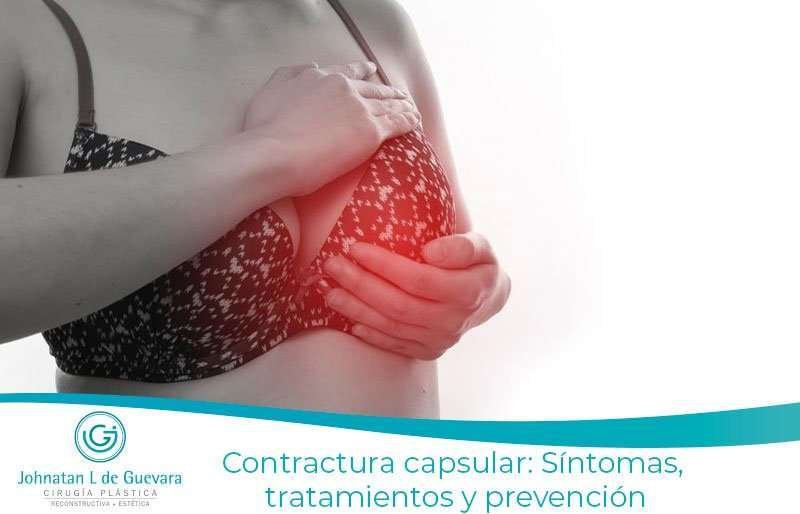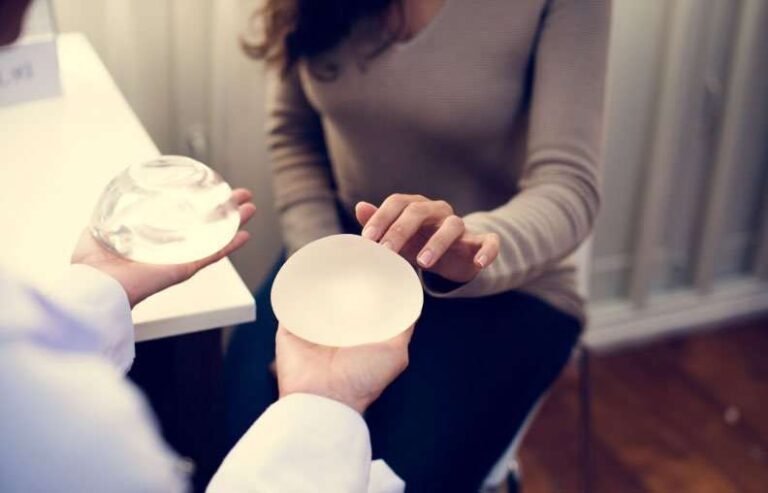What is capsular contracture?
Whenever there is a foreign object inside your body – a breast implant or a pacemaker, for example – your body reacts by creating a thin layer of scar tissue around it. This capsule is soft, flexible and completely normal.
In some cases, this scar tissue becomes thick and hard, pulling on the surrounding tissue. This pull constricts the tissue, making it less flexible.
When this happens with breast implants, a once soft breast begins to feel stiff. As the condition worsens, the breast also becomes misshapen and may appear hard and round against the chest.
Capsular contracture is most commonly associated with augmentation mammoplasty, but can occur any time a capsule forms around a foreign object in the body.
What causes capsular contracture?
Sometimes the cause is clear. Trauma to the breast, radiation and infection can cause capsular contracture. Post-surgical hematoma, a severe form of hematoma, has also been linked to an increased likelihood of developing capsular contracture.
Capsular contractures without a clear cause are commonly referred to as “silent” capsular contractures. Researchers theorize that bacterial contamination of the implant is the most likely cause in such cases: bacteria on the outside of the implant can trigger a greater than normal physical reaction, leading to excessive development of scar tissue.
There are also some risk factors that may indicate how likely you are to develop capsular contracture:
Autoimmune disorders – If you have an autoimmune disorder, such as lupus, your body already has an overactive immune system. It is likely to overreact to an implant.
Pregnancy – Researchers have noted a positive correlation between pregnancy and the incidence of capsular contracture.
Subglandular implant – This implant, placed below the mammary glands but above the pectoralis muscle, also increases the risk of capsular contracture.
Periareolar incision – This incision is located around the nipple. Researchers theorize that this type of incision leads to an increased risk of bacterial contamination.
Silicone implants – This is particularly true for older models of silicone implants. Silicone molecules sometimes leak out of the breast implant, a process known as gel bleed. This causes inflammation in the surrounding tissue.
Implant size – Implants that are too large for the available skin have an increased risk of capsular contracture.

What are the symptoms of capsular contracture?
As mentioned above, the body will form a scar capsule around all implanted devices, including breast implants. The types of capsules that form around breast implants are classified according to the Baker classification system:
Grade I – The breast is soft and natural. The patient cannot detect the presence of a capsule. This is normal capsule formation and essentially what every breast augmentation patient expects to have.
Grade II – The breast is slightly firm. It may be possible to feel the implant. The breast still looks natural.
Grade III – The breast is very firm and appears deformed. The implant can be easily felt. There may be mild discomfort.
Grade IV –The breast is hard and very deformed. The implant is painful, especially when pressure is applied. Different women experience different levels of pain with capsular contracture and these different degrees of pain fall into this category. You may find that the pain is totally manageable or simply unbearable.
Grade III and grade IV are considered capsular contractures.
When does capsular contracture occur?
Capsular contracture can occur at any time. This means that your implants could be perfectly fine for years before it occurs. However, the vast majority of people who develop the condition do so within the first few months after surgery.
Symptoms tend to develop gradually, even in cases of trauma. It is very unlikely that you will experience symptoms of capsular contracture only a few weeks after surgery. If you are experiencing firmness this early, it is probably because your implant has not yet settled.
Is capsular contracture dangerous?
Capsular contracture itself is not dangerous. When women seek medical help for this condition, it is largely due to the discomfort and shape of the breasts.
That said, it is important to consult your physician if you think you may have capsular contracture. The sooner the condition is treated, the better the chances of a successful outcome through non-surgical methods. Don’t rush to the emergency room, but make an appointment with a cosmetic physician as soon as possible.
Sometimes capsular contracture can be the result of a ruptured silicone implant. Some ruptures can be detected by ultrasound but, in many cases, an MRI is the only test sensitive enough to give a clear diagnosis.
Although studies have shown that ruptured implants do not put your health at risk, it is recommended that ruptured implants be removed or replaced.
What is capsular contracture surgery?
You may not want to hear this, but the only truly reliable solution for capsular contracture is total removal of the scar tissue, also known as capsulectomy.
In addition, it is recommended that the implant be removed as well, as there could have been a bacterial contaminant on the implant surface that triggered the capsular contracture. However, the implant can be replaced during the same procedure.
Some physicians may also recommend a capsulotomy, not to be confused with the closed capsulotomy mentioned below. This procedure does not remove all of the scar tissue, but simply goes in and breaks it up. This has also fallen out of favor in recent years, but some surgeons still recommend it when scarring is minimal.
Recovery from any of these procedures is similar to recovery from a regular breast augmentation.
Can capsular contracture be treated without surgery?
There are some non-surgical strategies to treat capsular contracture. However, none of them are guaranteed. Many of them do not undergo extensive testing, but are nevertheless considered safe.
Ultrasound – Some doctors use sound waves to soften the scar tissue around the implant. This method is also said to make the bacteria on the surface of the implant more vulnerable to your body’s immune system.
Vitamin E – Take this with a massive grain of salt. Despite claims, vitamin E has not been shown to soften scar tissue. This treatment is unlikely to produce the results you are looking for, but it is also unlikely to cause any harm. It is generally recommended to combine vitamin E with a method that has been shown to be more effective.
Anti-inflammatory medications – Physicians may prescribe Accolate or Singulair, two medications used to treat asthma. These drugs have been shown to soften scar tissue in some patients. However, the evidence has only been anecdotal. These drugs are unlikely to work in more advanced cases.
Massage – Some plastic surgeons swear by this method to prevent and treat capsular contracture in its early stages, while others do not find it worthwhile.
What about closed capsulotomy?
This used to be a fairly standard practice for treating capsular contracture, but has since fallen out of favor – and for good reason. Since you may have come across this term in your research, let’s talk about why you don’t have to bother asking your doctor about it.
During this procedure, a physician would squeeze the breast with great force, breaking up the scar tissue around the implant. When the scar tissue ruptures, an audible popping sound is heard accompanied by a lot of pain.
However, this is not the main reason why the procedure has fallen out of favor in the medical community. Closed capsulotomy is rarely performed, as it carries a high risk of implant rupture. This is dangerous, as it can lead to internal bleeding.
Will the capsular contracture get better on its own?
It may improve with the help of some of the non-surgical methods mentioned above. However, even that is uncertain. However, if you do nothing to treat it, it will not go away on its own and will probably only get worse.

How can I prevent capsular contracture?
There are a variety of steps you and your surgeon can take during and after surgery to reduce your chances of developing capsular contracture. If you are having breast implants, be sure to talk to your plastic surgeon about your concerns beforehand.
Submuscular implant
Have the implant placed under the pectoralis muscle. In theory, the movement of the muscle over the implant will massage the area and inhibit scar tissue growth.

Textured implant
The rough surface of textured implants is also said to inhibit scar tissue growth. The advantage of lower capsular contracture with textured implants only applies when placed over the muscle. When placed under the muscle, textured implants have not shown a decrease in capsular contracture rates compared to smooth implants.
No-Touch
This method of performing a breast augmentation involves opening the implant package just before inserting it into the body. Great care is taken not to allow the implants to touch bare skin or medical instruments. It should only come into contact with gloved hands and the inside of the breast.
The idea is to minimize any opportunity for bacteria to attach to the outside of the implant.
Irrigation with antibiotics
It has been shown that both pre-soaking of the implant to be placed and flushing of the breast implant pocket that is surgically created prior to insertion with a combination of cefazolin, gentamicin and bacitracin, decrease the incidence of capsular contracture.
Keller funnel
The Keller funnel is a device that aids in the insertion of a silicone implant through what is normally a small incision in the breast. It promotes the no-touch technique, preventing the implant from touching any contaminants that may be on the skin.
Closed filling
This is similar in principle to the no-touch method. In short, the surgeon uses a closed system to fill the saline implants. At no time is the saline exposed to air (and external contaminants).
Post-surgical massage
Your surgeon can instruct you on how to massage your breasts after the procedure. When you start and how often you do it will depend on the size and nature of your implants. However, people usually start one week after surgery and massage daily for the first few months.
Polyurethane-coated implants
In your research, you may have encountered polyurethane-coated implants. At one time these implants were popular for the prevention of capsular contractures and proved to be very effective. The foam-coated implants acted as textured implants, discouraging scar formation.
A 30-year study involving 382 patients noted that the more coating there is on an implant, the less likely the patient is to experience capsular contracture. However, researchers also noted that polyurethane had a tendency to be absorbed by the body, which raised some health concerns. As a result, they were discontinued in the United States. They have since been reintroduced, but are not widely used.
Can capsular contracture occur more than once?
Absolutely. If the factors that led to the initial development are not addressed, there is no reason why it cannot happen again.
That said, complete capsulectomies usually do not result in further recurrences of the condition. This is one of the reasons they are favored over capsulotomy. Simply put, removal of all scar tissue is considerably more effective than simple breakdown.
If you think you may be experiencing capsular contracture, contact a board-certified plastic surgeon such as Dr. Guevara for diagnosis and treatment options.



